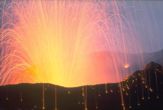Volcano Roots Run Deep

Hidden deep inside the Earth are rare pockets of exotic materials, the likes of which scientists have detected only once.
These materials may be "roots" that anchor mantle plumes - narrow pipes that bridge the gap between the Earth's crust and its super hot core. They may also be responsible for forming volcanic islands like Hawaii.
Mantle plumes produce "hot spots" - rare areas where a plume has burst through the crust and created a volcano. Scientists believe that the newly discovered ultra low velocity zones (ULVZ) are molten roots that anchor plumes.
"Plumes are related with hot-spot volcanism which builds up island chains like Hawaii and oceanic islands like Iceland," study co-author Sebastian Rost of Arizona State University told LiveScience. "Geodynamic modeling shows that these dense blobs of material (ULVZ's) don't move around a lot in the mantle. They may actually give a stable root to long lived mantle plumes and that might be the reason why we have island chains like Hawaii."
The ULVZ is a bubble of partially molten rock that sits right at the boundary layer between Earth's solid layer and its molten core. This particular bubble - located in the southwest Pacific Ocean east of Australia - is about 30 miles across and 5 miles deep.
The material in the bubble is significantly denser than area surrounding it, making it a good anchor.
Image Gallery Volcanoes
"Its higher density is the reason that mantle plumes are long lived and rather stationary," said Rost.
Sign up for the Live Science daily newsletter now
Get the world’s most fascinating discoveries delivered straight to your inbox.
Making an island
Oftentimes, mantle plumes breach tectonic plates on the ocean floor. As the plume spews hot material, it cools down rapidly and forms undersea mountains.
Sometimes the plume only spews a little material, forming structures called seamounts. But if the plume is very active, over time a mountain may emerge from the sea and form an island, like Iceland.
If the plume cracks through a moving plate, island chains like Hawaii may form. It's like putting a marker tip on a piece of paper and slowly moving the paper while keeping the marker still. Larger eruptions will occur at some spots, creating larger islands.
Finding a root
It takes just the right conditions to find possible volcanic roots. In fact, scientists have to wait for an earthquake to occur in just the right place to create seismic waves that will reflect off the structures.
"Seismology is a funny science, since we have to wait for earthquakes in the right distance range to seismic stations," Rost said. "But I am pretty optimistic that we will be able to find more of these structures."
The vast majority of volcanoes form in subduction zones - places where the plates that make up Earth's crust bump into each other. The volcanoes surrounding California and Washinton state mountains were created this way.
These findings were reported in the June 2 issue of Nature.
Related Stories
- Hole Drilled to Bottom of Earth's Crust, Breakthrough to Mantle Looms
- Finally, a Solid Look at Earth's Core
- 'Eel City' Forms at New Undersea Volcano
- How Volcanoes Work
- Ancient Sunken Islands Found Off California









